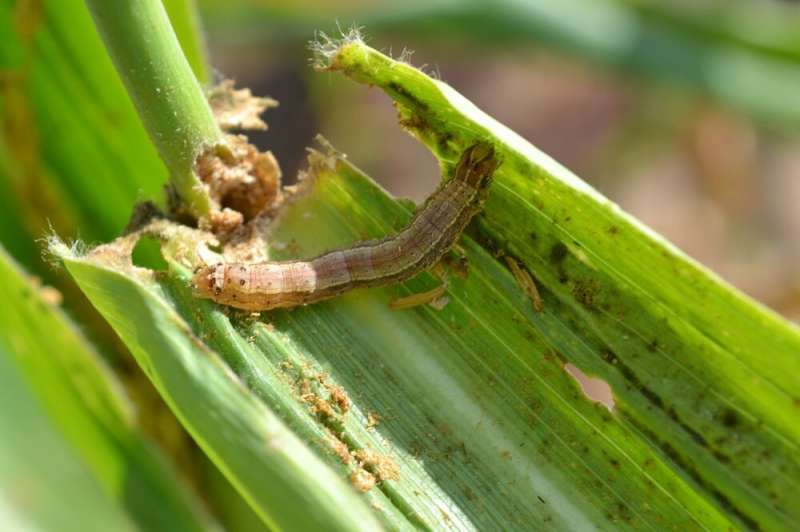This article has been reviewed according to Science X's editorial process and policies. Editors have highlighted the following attributes while ensuring the content's credibility:
fact-checked
peer-reviewed publication
proofread
Eiphosoma laphygmae likely to be best classical biological control against devastating fall armyworm pest

A review conducted by CABI scientist Dr. Marc Kenis suggests that the parasitoid Eiphosoma laphygmae is likely to be the best classical biological control from the Americas against the devastating fall armyworm pest.
Dr. Kenis, Head of Risk Analysis and Invasion Ecology, based at CABI's Swiss center in Delémont, evaluated the prospects and constraints of a classical biological control program to fight the fall armyworm (Spodoptera frugiperda) using larval parasitoids, which are considered the most suitable natural enemies of the pest.
His findings are published in the Journal of Economic Entomology.
The fall armyworm—which originates from tropical and subtropical areas of the Americas—is a highly destructive pest of over 350 plant species, though it favors staple foods of millions including maize, rice and sorghum.
A previous review led by Dr. Kenis, published in Entomologia Generalis, provided a comprehensive study of the fall armyworm including details on its invasiveness, biology, ecology and management. It involved 57 scientists from 46 different institutions.
The paper highlighted that according to Eschen et al. (2021), fall armyworm causes estimated annual yield losses of USD $9.4 billion in Africa alone. It adds that the invasion of the pest in developing countries has an important impact on household income and food security.
In the latest review, Dr. Kenis said the most important larval parasitoids in its native range are presented and discussed for their suitability as CBC agents, based the following criteria: their frequency of occurrence and parasitism levels, specificity, climatic suitability and absence of closely related species parasitizing the fall armyworm in the area of introduction.
Other parasitoids looked at included Aleiodes laphygmae, Archytas marmoratus, Campoletis spp. and Cotesia marginiventris.
Dr. Kenis said, "The ichneumonid Eiphosoma laphygmae Costa-Lima (Hymenoptera: Icheumonidae) is considered as a potential candidate for introduction because of its specificity and its importance as a parasitoid of the pest in most of its native range.
"The most frequent and important parasitoid of S. frugiperda in the Americas, the braconid Chelonus insularis Cresson (Hymenoptera: Braconidae), would most probably contribute to the control of S. frugiperda if released in invaded areas. However, it is oligophagous and would most certainly parasitize nontarget species."
He added that before introducing C. insularis, or any other parasitoid species, the potential non-target effects will have to be assessed and the risks will have to be weighed against the benefits of improving the natural control of this important pest.
Other CABI research to try and mitigate the fall armyworm has included a former Ph.D. student, Patrick Fallet, from the University of Neuchâtel and CABI in Switzerland, testing numerous nematode formulations applied into the maize whorl. These have proved just as effective as pesticide sprays.
Meanwhile, scientists from the MARA China-CABI Joint Laboratory for Biosafety and MARA China-CABI European Laboratory are working to find sustainable and effective natural enemies for the fall armyworm with 70 options identified in China alone.
These include 44 predators such as Pentatomidae, Lygaeidae, Anthocoridae, Nabidae, Coccinellidae, Reduviidae, Chrysopidae, Forficulidae, Formicidae and Vespidae species. Bugs and beetles constitute 68% of the predators.
More information: Marc Kenis, Prospects for classical biological control of Spodoptera frugiperda (Lepidoptera: Noctuidae) in invaded areas using parasitoids from the Americas, (2023). DOI: 10.1093/jee/toad029
Journal information: Journal of Economic Entomology
Provided by CABI




















